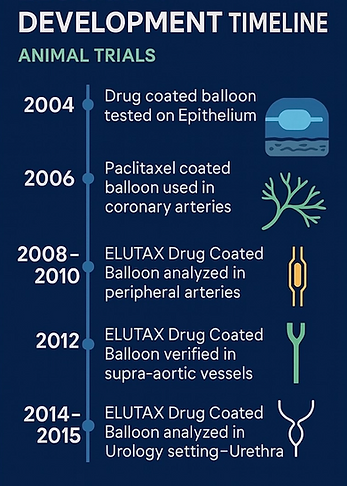WHO WE ARE
AR Baltic Medical LLC:
Advancing Patient-Centered Technologies
We are based in Kyiv, Ukraine. Our company is a member of the AR Group. AR Group companies are separate legal entities subject to the laws and regulators of their respective jurisdictions. The AR Group was founded in 2001 in Aachen, Germany. AR Baltic Medical UAB in Vilnius, Lithuania was founded in 2006, and is now a manufacturer of high-quality medical devices, with a particular focus on drug-coated balloon catheters. In 2018 a second manufacturing plant was established in Budapest, Hungary. In addition to production and sterilisation of our products - we have a dedicated research team in Budapest to develop innovative products.
Our Mission
To support physicians and patients by delivering reliable, high-quality devices intended for effective and safe treatment.
Our Experience and Innovation
Our proprietary drug-coating platform has been used in the
European market since 2007 and was the first CE-marked coating
of its kind. Over the years, the formulation has been continuously
refined to improve clinical performance and drug transfer
characteristics.
Since the beginning of our history, we have believed that drug-coated
balloon technology should not be limited to vascular applications
alone, but holds potential across a wide range of anatomical territories.
Our core philosophy has always been that fibrotic proliferations—
regardless of their anatomical location—can be effectively treated
using pathology-targeted balloon-based therapy.
This conviction has shaped our development strategy from the outset,
enabling us to build a uniquely broad clinical foundation supported by
real-world data and histo-pathologic research across both vascular
and non-vascular applications.
As a result of this long-standing experience, we are — to the best of
our knowledge — the only company worldwide with
clinical evidence in:
-
Intracranial applications
-
Supra-aortic vessels
-
Peripheral arteries
-
Coronary arteries
-
Veins & dialysis AV fistulas
-
Atherosclerotic lesions and fibrotic strictures in Ureter and Urethra.
This extensive clinical footprint supports the pathology-driven use of our device across a wide range of anatomical territories.
Drug-Coating Technology
Our catheters feature a proprietary Paclitaxel–Dextran formulation, engineered for targeted drug delivery and consistent coating transfer. The excipient system enhances Paclitaxel adhesion and persistence in tissue while preserving drug stability throughout the procedure. This enables effective performance with a lower target Paclitaxel dose of 2.2 µg/mm²—approximately 40% less than many competing products—thereby reducing the potential for systemic exposure and local toxicity.
This safety advantage is particularly relevant in anatomically sensitive regions such as the heart, brain, and reproductive organs, where high local drug concentrations may raise clinical concerns. In the central nervous system, the blood–brain barrier (BBB) normally limits exposure to circulating toxins; however, this protection is absent in other anatomical regions where drug-coated devices are applied directly. Similarly, the heart and reproductive organs are highly vascularized and lack selective barriers, potentially increasing their susceptibility to localized toxicity from high-dose formulations.
Our proprietary Paclitaxel–Dextran formulation was specifically selected for its well-documented bioadhesive and biocompatible properties, which are not limited to vascular applications. Dextran is used beyond vascular use, including in ophthalmology (e.g., as a carrier in eye drops), urology (as instillation agents, hydrogels, and nanoparticle systems), and for intravesical delivery of chemotherapeutic agents. Its biocompatibility and controlled drug-release behavior make it particularly suitable for non-vascular environments—especially where mucosal surfaces are sensitive, tissues are directly exposed, and a long residence time with minimal burst release is clinically advantageous. This makes Dextran an ideal excipient for drug delivery in urological regions such as the urethra or ureter. Validated Tissue Uptake
In preclinical studies, ELUTAX “3” achieved up to 15 ng/mg paclitaxel retention in urethral tissue at 30 days — significantly outperforming published data from leading competitors.
Design Considerations
Each catheter is engineered with low-profile balloon technology to improve trackability, navigability, and precision — while reducing trauma and maximizing procedural efficiency.
Vascular and Non-Vascular Applications — Pathology-Driven Use
In addition to vascular indications, our ELUTAX “3”-OTW catheter is indicated for fibrotic and atherosclerotic strictures in anatomical conduits according our Ukranian Certificate and other national approvals.
These applications are specifically supported by clinical evidence and recognized within the pathology-based intended purpose defined in our IFU and technical documentation. However, the IFU for each country may be different and the IFU is defining the scope of the device in these countries.
Sales and Distribution
Products are sold exclusively through authorized and qualified distributors, or in response to individual, unsolicited requests from licensed healthcare professionals. The company does not participate directly in public tenders, hospital procurement, or marketing campaigns.
AR Baltic Medical products are supplied under applicable local regulatory authorizations. Promotion and distribution are managed independently by local distributors, in accordance with national laws and medical device regulations.
Market Access and Fair Competition
While we may appoint exclusive or sole distributors in specific regions, these appointments do not restrict the rights of other authorized distributors to sell our products in the same markets. AR Baltic Medical fully supports the principles of the free movement of goods and open competition.
We adhere to all applicable competition and antitrust laws, including:
-
Articles 34–36, 101, and 102 of the Treaty on the Functioning of the European Union (TFEU)
-
Regulation (EC) No 1/2003
-
The Sherman Act (1890), Clayton Act (1914), and FTC Act (1914) in the U.S.
-
The UK Competition Act (1998) and Enterprise Act (2002)
-
The German GWB (Gesetz gegen Wettbewerbsbeschränkungen)
-
The French Code de commerce (Livre IV)
This website provides general product information for international audiences. It is not an offer for sale in any jurisdiction. Availability and authorized indications vary by country. Refer to local labeling.

In-house Production

CONTACT US
Interested in placing an order or learning more? Simply reach out today.
30 Vasylkivska Street, 03022 Kyiv, Ukraine
Helpline: 24/7/365
+33 6 21273746



